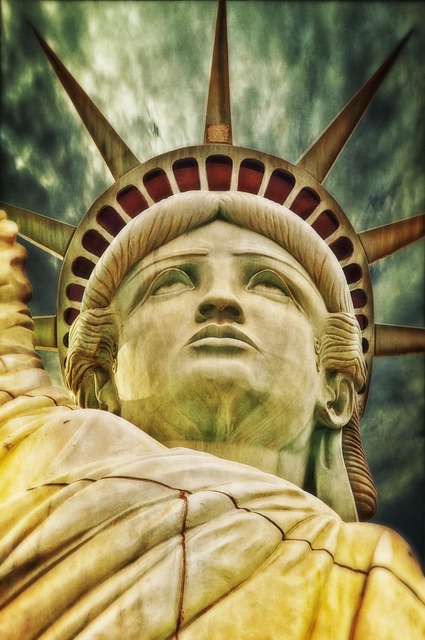She’s one of the most recognizable landmarks in the world. A 305-foot-tall icon of freedom, a symbol of hope for millions, and the undisputed star of New York Harbor. But for a monument so famous, Lady Liberty is holding on to a lot of secrets.
From her real name to her original color, here are 10 fascinating facts you probably didn’t know about the Statue of Liberty.
1. Her Full, Formal Name Isn’t “Statue of Liberty”
We all call her the Statue of Liberty, or Lady Liberty, but that’s just a nickname. Her official name, given by her creators, is “Liberty Enlightening the World” (or La Liberté éclairant le monde in French). This grand title frames her not just as an icon of liberty, but as a beacon of it, actively sharing enlightenment with the world.
2. She Was Originally a Shiny Copper-Brown
That iconic sea-foam green? It’s not paint; it’s a “patina,” and it wasn’t the original look. When she was unveiled in 1886, the Statue was the dull, brownish-bronze color of a new copper penny. It took approximately 25-30 years for the thin copper skin (which is only 3/32 of an inch thick) to oxidize and react with the air, water, and pollution of New York Harbor, gradually forming the protective green layer we see today.

3. Her Green Patina Is a Natural Shield
When Lady Liberty first started turning green in the early 1900s, it caused a public panic. Many officials and newspapers called for her to be “cleaned” and repainted. In 1906, Congress even appropriated funds to paint the entire statue. However, experts at the time advised that the green patina was not a sign of decay but was, in fact, a natural protective layer (verdigris) that was shielding the copper skin from further corrosion and damage.
4. She Is Standing on Broken Chains
This is one of the most powerful and overlooked details of the statue. If you could see her from above, you would notice that Lady Liberty’s feet are not firmly planted. Her right foot is raised, and she is in mid-stride, walking forward. As she moves, she is stepping over a broken shackle and chains that are partially hidden by her robes. This was a crucial symbol for her creators, representing a rejection of tyranny and, specifically, the abolition of slavery.
5. She Was Briefly a Lighthouse (But Not a Good One)
From 1886 to 1902, the Statue of Liberty was officially a functional, “A-1” lighthouse, operated by the U.S. Lighthouse Board. The problem? It was a terrible lighthouse. The light from her torch, even after being upgraded, was too dim to be a useful navigational aid for ships. It was so ineffective that the Lighthouse Board, which had a budget to maintain, was reportedly relieved when the War Department took over the statue in 1902.

6. America’s First “GoFundMe” Paid for Her Pedestal
France paid for the statue itself, but America was responsible for funding and building the massive stone pedestal she stands on. By 1884, funding for the pedestal had completely dried up, and the project was in danger of failing.
Enter Joseph Pulitzer (of the Pulitzer Prize). He launched a massive, six-month fundraising campaign in his newspaper, the New York World. He promised to print the name of every single person who donated, no matter how small the amount. The campaign was a wild success, raising over $100,000 (a huge sum at the time) from more than 125,000 people, most of whom gave less than a dollar.
7. Her “Guts” Were Designed by Gustave Eiffel
Sculptor Frédéric-Auguste Bartholdi designed the statue’s exterior, but he needed a brilliant engineer to figure out how to keep the 305-foot-tall, 450,000-pound copper structure standing. He hired the best: Gustave Eiffel.
Eiffel (yes, that Eiffel) designed a brilliant internal iron-and-steel pylon that acts as a central spine. This framework supports the thin copper skin, allowing it to “float” independently, which is why she can withstand hurricane-force winds by swaying several inches.
8. Her Crown’s 7 Spikes Represent the World
The seven spikes on her crown, or diadem, are not just for decoration. They are meant to represent the seven continents and the seven seas of the world, reinforcing the universal message of liberty. The 25 windows in the crown are said to represent “natural minerals” or “gemstones” of the Earth.
9. Her Torch Was Replaced Due to a WWI Sabotage
The original torch was damaged by decades of rain and snow leaking in through its glass panels. But the final straw came on July 30, 1916, during World War I. German saboteurs blew up a massive munitions depot on the nearby Black Tom Island (now part of Liberty State Park).
The explosion was so powerful it registered as an earthquake, shattering windows in Manhattan and sending shrapnel flying. The Statue of Liberty was hit, damaging the torch and her arm. Public access to the torch was closed permanently. In 1986, the original, damaged torch was replaced with the gold-plated one we see today. The original is now on display in the Statue of Liberty Museum.
10. Her Face Was Likely Modeled on the Sculptor’s Mother
While the statue’s body was reportedly modeled after the sculptor’s wife, the stern, strong-jawed face of Lady Liberty is widely believed to be modeled after someone even closer to him: his mother, Charlotte Bartholdi.
Have you visited the Statue of Liberty? What’s your favorite piece of her history? Let us know in the comments!



